2020 年广东财经大学英语水平考试考研真题
考试年度:2020 年
考试科目代码及名称:613-英语水平考试(自命题)
适用专业:050201 英语语言文学
[友情提醒:请在考点提供的专用答题纸上答题,答在本卷或草稿纸上无效!]
一、 Gap Filling 选词填空(从列表的单词中选择合适的词完成段落/非 Cloze 选择填
空)(30 题,每题 1 分,共 30 分)
Directions:Fillinthegapsnumbered1to30withappropriatewordsfromtheword
list. There are more words than needed and each word can be used only ONCE. Write
downtheletters(AtoT)representingthewordsafterthenumbers1to30foreach
passage on the Answer Sheet.
Passage One
A. defined B. emerged C. broadly D. process
F. forwards G. onwards H. distinct
K. refined L. markets M. agents N. urgency
S. marginal
P. crucially Q. directly R. tools
I. distant
E. circulation
J. informational
O. scale
T. shaped
The term “globalization” has been used to 1
describe the profound
nature of changes affecting economies, cultures and societies worldwide from the
late twentieth century 2
. Anthony Giddens has 3
globalization as “the
intensification of worldwide social relations which link 4
localities in such
a way that local happenings are 5
by events occurring many miles away and vice
versa”.
A central feature of the new, global economy which has 6
in the context of
intensified relations is that it is 7
. That is to say, the productivity and
competitiveness of firms in the new economic order depend on their ability to create,
8
and apply knowledge-based information. Alongside the centrality of
information and knowledge, a further 9
feature is the nature of economic
organization which has emerged in late modernity. The central activities of
production, consumption and 10
, as well as their components (capital, raw
materials, management, information, technology, 11
), are organized on a global
12
, either 13
or through a network of connections between different
economic 14
. The importance of the information technology revolution from the
1970s onwards was that it provided the 15
or the material basis for this new
�
economy.
Passage Two
A. sold
F. gradually
K. translated
P. editions
B. revolutionary C. relative
G. reaching
L. destined
Q. versions
H. psychiatrist
M. admitted
R. initial
E. relationship
D. trivial
I. dramatically
J. proposed
N. dismissed O. disciplines
T. disciples
S. psychology
Freud’s TheInterpretationofDreamswas published in 1900, a remarkable year
that was 16
to change the world’s thinking profoundly. Its 17
reception
was saddening – only 351 copies were 18
during the first ten years. Later,
its value was 19
realized by scholars, and the book went eight 20
before
the death of its author. Now, more than a hundred years has already passed, and it
has been 21
into more than a dozen languages. Its influence is far 22
:
it has profoundly changed the landscape not only in 23
, but also in literature,
art, aesthetics, anthropology, philosophy, education, sociology and other 24
.
It is reckoned as one of the three 25
books together with Darwin’s Origins
of the Species and Copernicus’ De Revolutionibus Orbium Coelestium.
Before Freud, dreams were not seriously considered. It was 26
as
superficial, insignificant and 27
. Freud worked as a 28
for many years,
dealing with hysteria. He collected many cases and began to think seriously of the
29 between dreams and the psychological condition of patients. In this book, he 30
that dreams were the fulfillment of human wishes.
二、 Proofreading and error correction 改错题 (15 题,每题 2 分,共 30 分)
Directions:Thefollowingpassagecontains15errorswhichareindicatedbyanumber
aftertheline.IneachindicatedlinethereisonlyONEerror,andforeacherror,
you just need to change ONE word to make it correct. Write down the correct word
on the Answer Sheet.
Around 1990 a number of architect around the world began developing new architectural
solutions to integrate tradition for new social demands and technological
possibilities. The struggle between old and new initiate the birth of a new
architecture style – the International Style. The international style stresses
minimalism and functionalism, rejects all essential decorative elements and is
�
ignorant to regional characteristics. The ideals of the style are also commonly sum
up in four slogans: ornament is a crime, truth to materials, form follows function,
and “machines for living.” This could be sound explained in light of the Western
industrialization. With their rapid
development, society was also changing and
evolved rapidly. There was a great demand for constructing better and affordable
buildings for factories, industries, commercial complexes, and residential purposes.
Thus, the overdoing ornamentation of the buildings of the previous eras, that
demanded high level of craftsmanship and was time-consuming, gave way in the simple
designs.
The international style first blossomed in western Europe, and than it began
to flourish in the United States, and matured after World War II. Its became the
dominant approach in the US for much decades.
1.__________ 2.__________ 3.__________ 4.__________ 5.__________ 6.__________
7.__________ 8.__________ 9.__________ 10.__________ 11.__________ 12.__________
13.__________ 14.__________ 15.__________
三、 Sentence Completion 完成句子(根据提供的词,用合适的词的形式完成句子)(15
题,每题 2 分,共 30 分)
Directions: Fill in the gaps with the proper forms of the given words. Write down
your answers on the Answer Sheet.
1.
Benjamin Franklin, an American who was at home wherever he went, gained wide
__________ in France and also became well known in England. (popular)
2. Although women have been __________ against unjustly, they had been patient until
recently. (discrimination)
3. As __________ in high places became widespread, the Roman Empire was considerably
weakened. (corrupt)
4. In response to the self-study problems, this college has evolved programs to meet
the ever-__________ needs of its students. (expansion)
5. Both animals and humans have been found to cope better with painful or __________
stimuli when they feel they can exercise some degree of control rather than being
passive and helpless. (threat)
6. Whereas some jobs may make heavier psychological demands than others, certain
�
sorts of people, __________ of their occupation, seem to make heavy psychological
demands on themselves – and , as a result, run a greater risk of heart disease.
(regard)
7. Friendships must be mutually productive. They must not be __________ to either
person. (destroy)
8. While global warming is __________ an important factor, it does not fully account
for these extreme and unusual weather patterns. (doubt)
9. Touch may communicate positive emotions mainly between intimates or others who
have a _________ close relationship. (relation)
10. Modelling is a better way to __________ children than punishment. (social)
11. Negative events are more __________ to be reported than positive ones. (like)
12. Reforms have brought about rapid __________ growth in China in recent years.
(economy)
13. Knowledge often results only after __________ investigation. (persist)
14. There are three kinds of book owners. The first has all the standard sets and
best-sellers – unread, __________. (touch)
15. Real beauty is a ___________ of external and internal beauty. (combine)
四、Reading Comprehension 阅读理解(30 题,每题 2 分,共 60 分)
Directions:Readthefollowingpassagesandchoosethebestanswersforthequestions
numbered1to30.WritedowntheletterofyourchoiceforeachquestionontheAnswer
Sheet.
Passage One
Cate Siu is from Hong Kong, but she's a fan of Korean television shows and she
keeps up with gossip about Korean celebrities on the Internet. Her favorite is a
beautiful soap-opera star, Song Hye Kyo, whose bee-stung lips and feminine features
she admires.
"Korean actresses have prominent and elegant noses," says Ms. Siu, a 25-year-old
aspiring actress. "They look so pretty."
So, when Ms. Siu decided she'd have a better shot at breaking into the
entertainment business after improving her looks with a surgical makeover, she knew
where she wanted to go. In April, she flew more than 1,000 miles to a clinic in Seoul
�
for operations to raise the bridge of her nose, make her eyes appear larger, and
sharpen her chin.
Across Asia, Korea is cool. From fashion to music to film, the country of 48
million people is redefining style. And as notions of Korean beauty become
popularized by the country's exploding cultural exports, women from around the
region – and some men, too – are flocking to Seoul to have their faces remodeled.
"A lot of my patients bring a picture of a Korean star from a magazine and say,
'I want to look like that,'" says Chung Jong Pil, a surgeon who runs the Cinderella
Plastic Surgery Clinic in a fashionable Seoul neighborhood.
Dr. Chung estimates that just under ten percent of his customers come from
overseas; the rest are locals. Most of the foreign visitors come from China, he says.
Jung Dong Hak, a surgeon who specializes in rhinoplasty, or nose jobs, at another
Seoul clinic, says roughly 15 percent of his patients are foreign. That number has
been rising in the past few years. "The increase has been very big since the Korean
wave started," he says.
1. Where is the article most probably published?
A. in an academic journal
B. in a science magazine
C. in a book
D. in a newspaper
2. What kind of lips does Cate Siu like?
A. thick
B. thin
C. small
D. pink
3. What kind of nose does Cate Siu want to have?
A. tiny and rounded
B. large and noticeable
C. dark and thin
D. flat and delicate
4. The name of Chung Jong Pil's clinic derives from _________.
A. a novel
B. a fairytale
C. a poem
D. an essay
�
5. From Dr. Jung we can know that __________.
A. most of his foreign customers are the Chinese
B. more foreigners than locals take plastic surgery in Korea
C. more and more foreigners come to Korea for plastic surgery
D. most of his customers are locals
Passage Two
From early adulthood to middle adulthood, people typically experience a
strengthening sense of identity, confidence, and self-esteem. In later life,
challenges arise. Income shrinks, work is often taken away, the body deteriorates,
recall fades, energy wanes, family members and friends die or move away, and the
great enemy, death, looms ever closer. It is not surprising that many presume the
over-65 years to be the worst of times. But, they are not, as Ronald Inglehart
discovered
when
he
amassed
interviewed
conducted
during
the
1980s
with
representative samples of nearly 170,000 people from 16 nations. Older people report
as much happiness and satisfaction with life as younger people do.
If anything, positive feelings grow after midlife and negative feelings subside.
Older adults increasingly use words that convey positive emotions. They attend less
and less to negative information. For example, they are slower than younger adults
to perceive negative faces. Their amygdale, a neural processing center for emotions,
shows diminishing activity in response to negative events while maintaining its
responsiveness to positive events. Moreover, the bad feelings we associate with
negative events fade faster than do the good feelings we associate positive events.
This contributes to most older people’s sense that life, on balance, has been mostly
good. Given that growing older is an outcome of living (an outcome nearly all of
us prefer to early dying), the positivity of later life is comforting.
6. It is generally believed that __________.
A. older adults have a stronger sense of identity
B. older adults have fewer friends
�
C. there are many problems associated with older adulthood
D. there is a positive side of older adulthood
7. It can be inferred from the passage that Ronald Inglehart is __________.
A. a scholar
B. an interviewer
C. a scientist
D.
a reporter
8. The level of happiness and satisfaction in old age __________.
A. is about the same as younger people’s
B. is obviously different from younger people’s
C. is significantly lower than younger people’s
D. is significantly higher than younger people’s
9. The brain of older people tends to __________.
A. notice negative events around them rather than positive ones
B. ignore negative events and only notice positive ones
C. more quickly forget the negative things that happen and remember the positive
ones
D. more quickly forget the positive things that happen and remember the negative
ones
10. The research results mentioned in the text can contribute to a more __________
attitude toward older adulthood.
A. pessimistic
B. optimistic
C. dubious
D.
uncertain
Passage Three
Today, in the hospital, surgeons and physicians have equal status. The studies
of internal medicine and surgery seem supplementary to each other and are therefore
treated equally. We may easily take it for granted that it was the same in the past.
In fact, historically speaking, internal medicine and surgery had quite different
histories, reputations and professions.
In the middle ages, in order to become a physician, one must study in a university
first in liberal arts for five years, then in medicine for four years. After the
�
long study was finished, he had to pass strict exams to graduate. He then had to
obtain a license in order to begin his practice. In other words, physicians should
learn from the books. A true doctor was believed to treat patients with remedies,
i.e., medicine, instead of giving physical intervention. Physicians were held in
high regard.
Surgeons were not ranked as high as physicians. Their profession was viewed as
a “trade” (i.e. an occupation, especially one requiring skilled labor; craft),
not as an “art”. Clerics used to help ill people, which was a natural calling of
the Christian doctrine. But their help usually came in the form of religious prayer,
and care for patients. They were forbidden to perform surgery because they were not
to “spill blood”. Medical doctors, or physicians, looked down upon the profession
as a “trade” beneath them and were unwilling to perform surgeries. The most suitable
person for the performance of surgery was the barber, who often dealt with small
cuts when they were giving a close shave. They were prepared with bandage and styptics
(drugs used to stop bleeding). So when someone had an injury, or an ailment that
required cutting, the barber was the most skilled person – he was a tradesman with
the necessary skills. Thus the profession was often called the barber surgeon.
11. It is a popular illusion that __________.
A. surgeons and physician have equal status
B. surgeons and physician enjoyed equal status
C. the studies of internal medicine and surgery are treated equally
D. internal medicine and surgery had different reputations
12. Which of the following statements about a physician in the middle ages is FALSE?
A. A physician must study 9 years in a university.
B. It was hard to become a physician.
C. A physician was highly reputed.
D. A physician was forbidden to operate on patients.
13. What can be known about “clerics” in the past from the passage?
A. They could perform surgery.
B. It was their mission to help ill people.
�
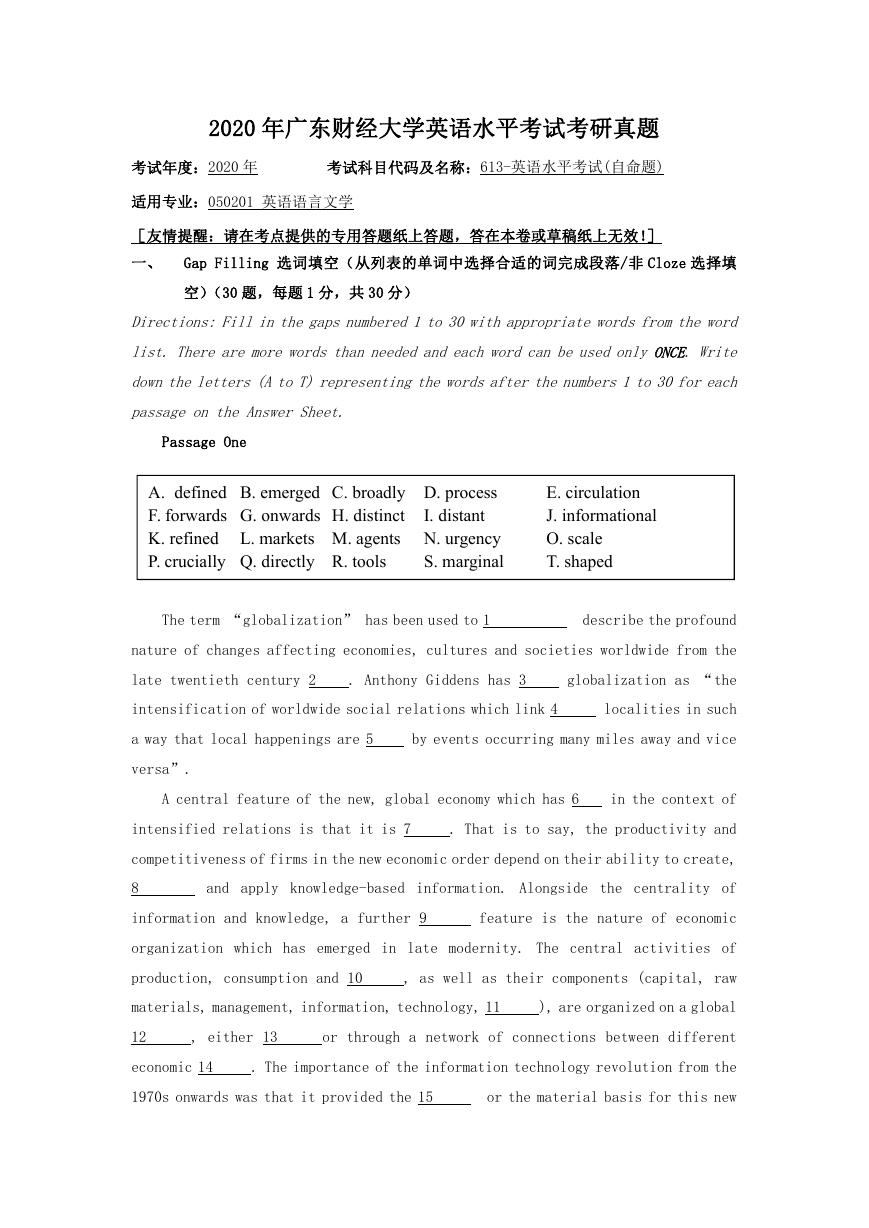
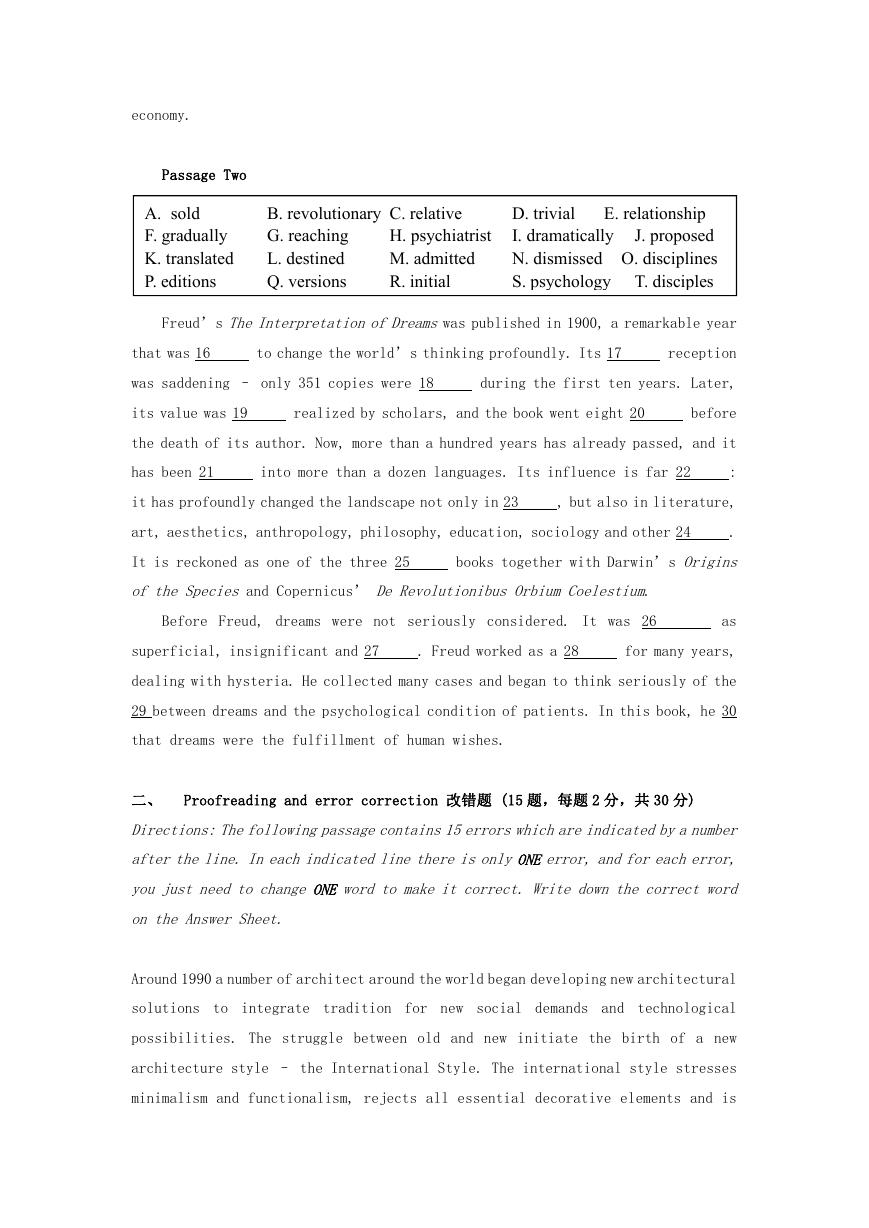

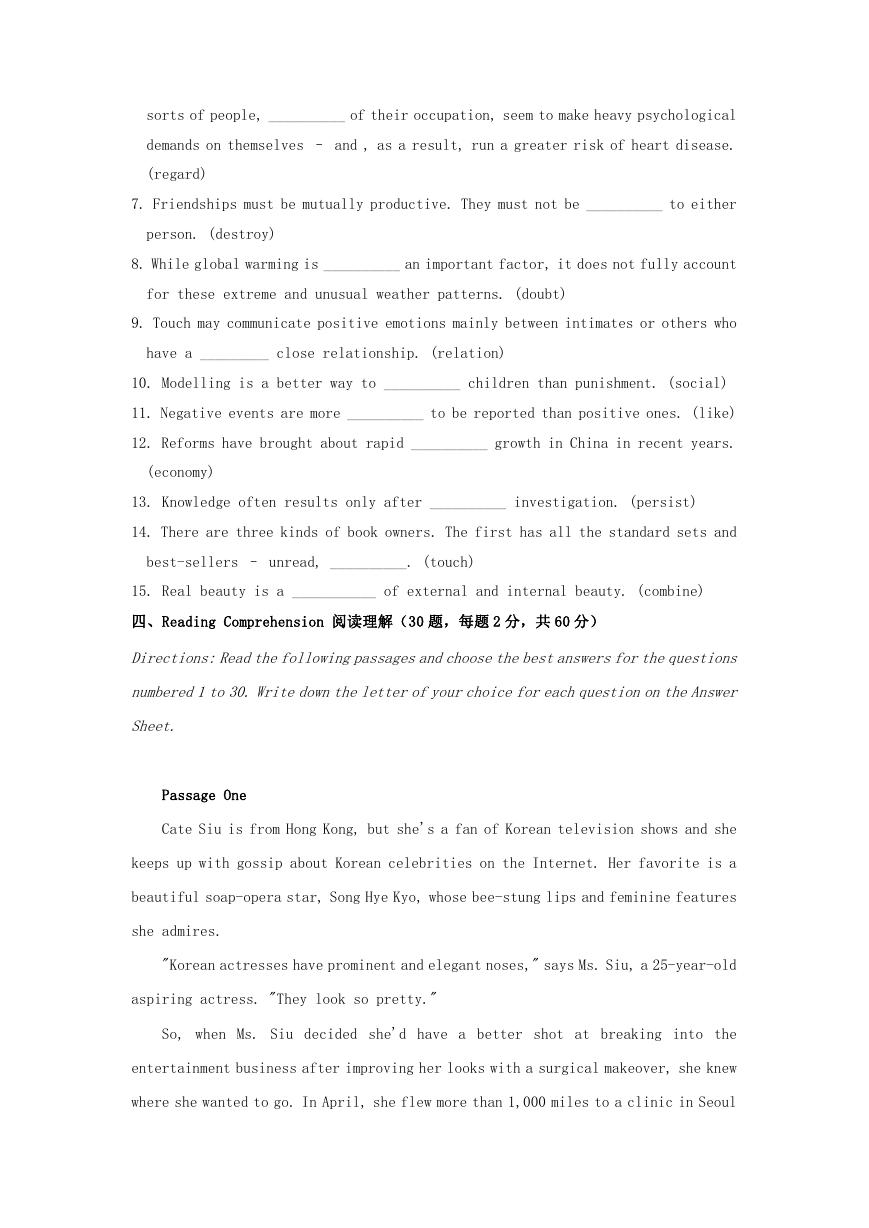

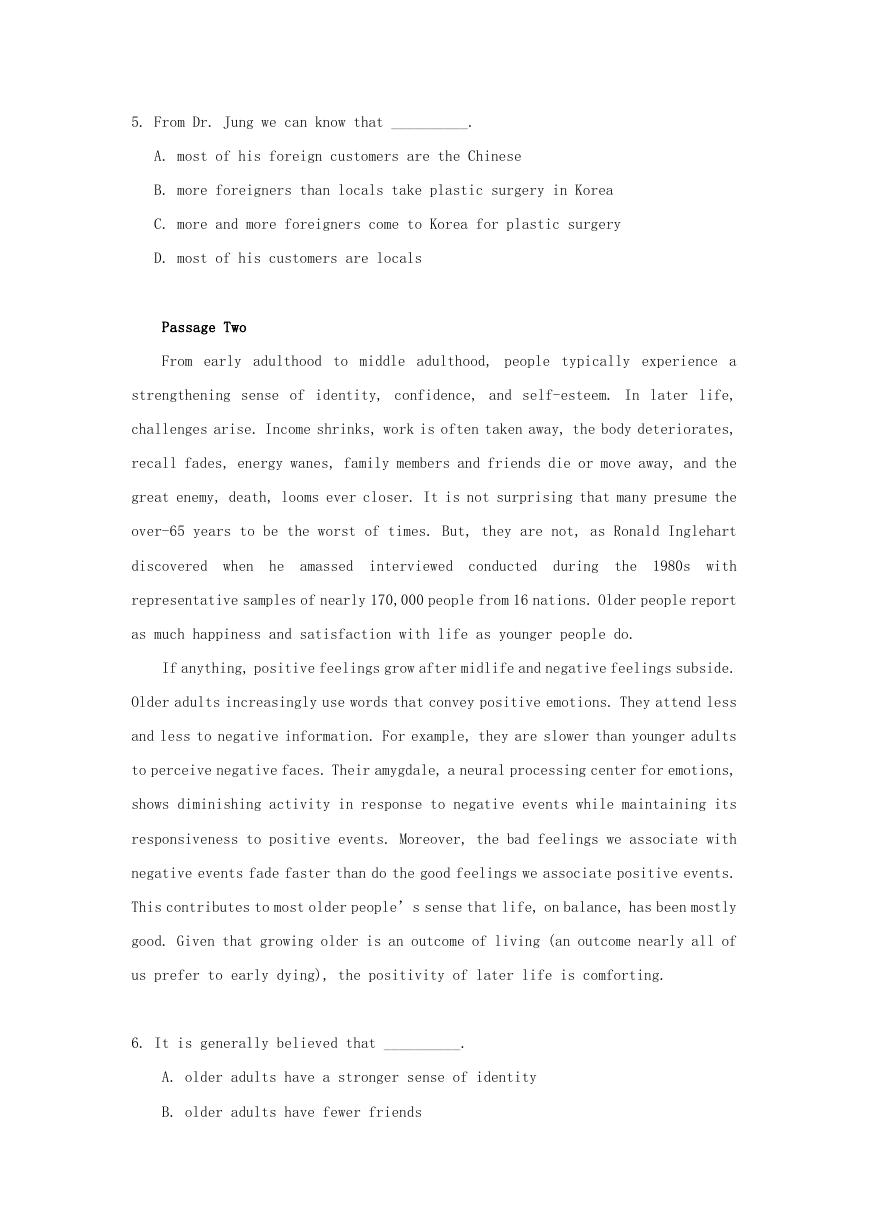
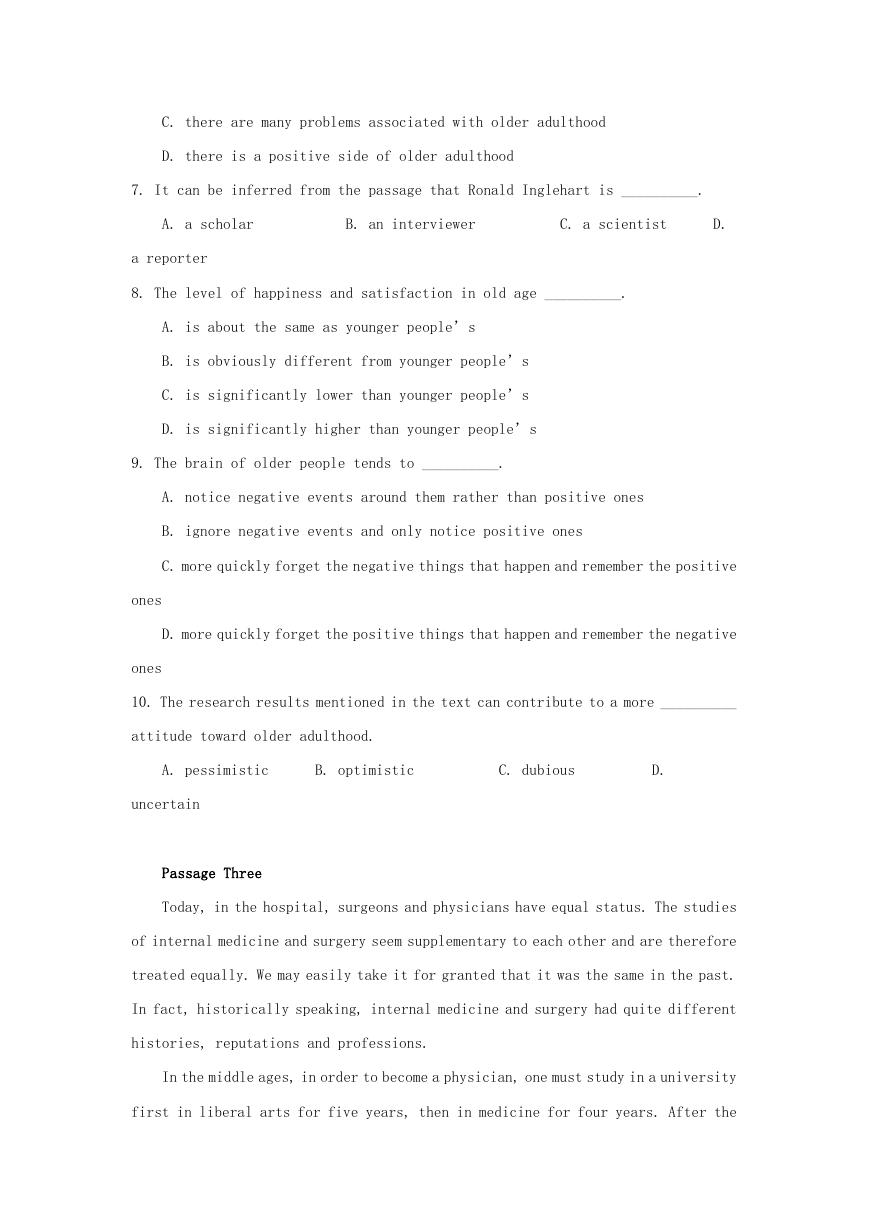
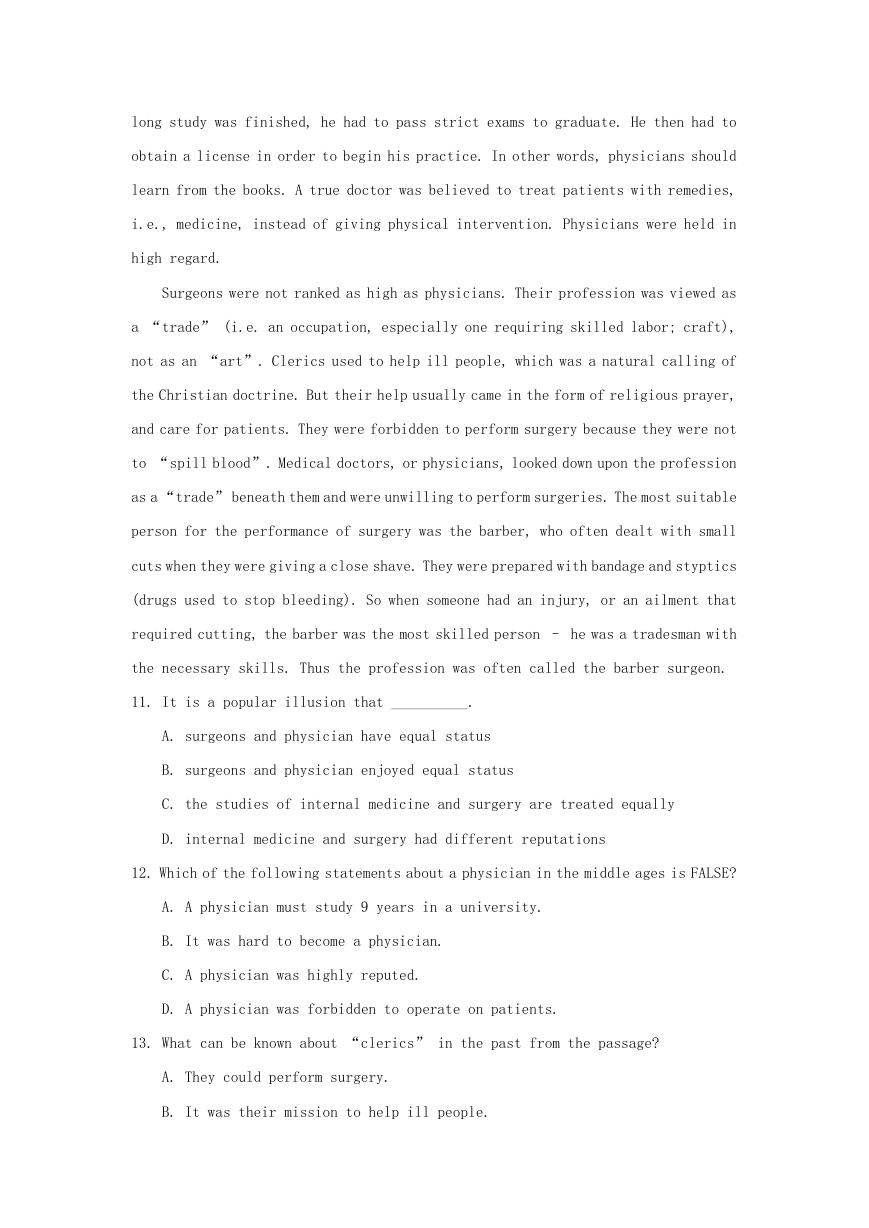








 2023年江西萍乡中考道德与法治真题及答案.doc
2023年江西萍乡中考道德与法治真题及答案.doc 2012年重庆南川中考生物真题及答案.doc
2012年重庆南川中考生物真题及答案.doc 2013年江西师范大学地理学综合及文艺理论基础考研真题.doc
2013年江西师范大学地理学综合及文艺理论基础考研真题.doc 2020年四川甘孜小升初语文真题及答案I卷.doc
2020年四川甘孜小升初语文真题及答案I卷.doc 2020年注册岩土工程师专业基础考试真题及答案.doc
2020年注册岩土工程师专业基础考试真题及答案.doc 2023-2024学年福建省厦门市九年级上学期数学月考试题及答案.doc
2023-2024学年福建省厦门市九年级上学期数学月考试题及答案.doc 2021-2022学年辽宁省沈阳市大东区九年级上学期语文期末试题及答案.doc
2021-2022学年辽宁省沈阳市大东区九年级上学期语文期末试题及答案.doc 2022-2023学年北京东城区初三第一学期物理期末试卷及答案.doc
2022-2023学年北京东城区初三第一学期物理期末试卷及答案.doc 2018上半年江西教师资格初中地理学科知识与教学能力真题及答案.doc
2018上半年江西教师资格初中地理学科知识与教学能力真题及答案.doc 2012年河北国家公务员申论考试真题及答案-省级.doc
2012年河北国家公务员申论考试真题及答案-省级.doc 2020-2021学年江苏省扬州市江都区邵樊片九年级上学期数学第一次质量检测试题及答案.doc
2020-2021学年江苏省扬州市江都区邵樊片九年级上学期数学第一次质量检测试题及答案.doc 2022下半年黑龙江教师资格证中学综合素质真题及答案.doc
2022下半年黑龙江教师资格证中学综合素质真题及答案.doc